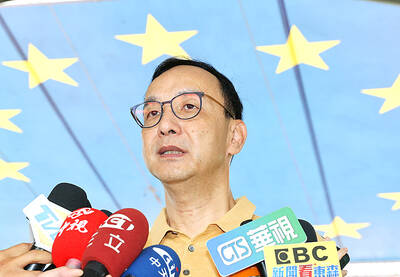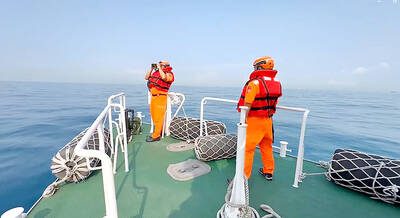Cold War detritus scars the white-sand beach on the island. Concrete barriers meant to halt invading tanks stand sentinel, waiting for an invasion that never came.
In the water, hundreds of rusting, sharpened steel barricades point menacingly toward the bustling Chinese city of Xiamen, whose skyscrapers poke through the midday haze a little more than 4.8km away.
The soldiers who manned the coastal defenses are long gone, though some have been replaced by life-size statues for the benefit of the many tourists who flock to the site. The most imminent danger now is to beachcombers who fail to pick up after their dogs. Signs warn they face a stiff fine: payable in New Taiwan dollars.

Photo: Reuters
Kinmen County’s Lieyu Township (烈嶼), encompassing what is known as Lesser Kinmen Island, is not controlled by the People’s Republic of China, nor is the much larger Kinmen Island nearby, even though both sit on the approaches to one of China’s busiest ports.
The Chinese People’s Liberation Army was never able to wrest control of the strategic islands from former Republic of China leader Chiang Kai-shek (蔣介石), who fled to Taiwan with his Chinese Nationalist Party (KMT) forces in 1949 after losing the Chinese Civil War to Mao Zedong’s (毛澤東) communists.
Chiang, who died in 1975, still watches over the island. A statue of him, doffing his peaked cap, towers over an overgrown athletics field where cows graze. A basketball court and chin-up bars once used by front-line soldiers are slowly surrendering to the lush subtropical vegetation.
Kinmen, formerly called Quemoy, was once a household name in the US. The nationalists and communists engaged in huge artillery duels there in the 1950s, raising tensions among Washington, Beijing and Moscow as then-US president Dwight D. Eisenhower and his secretary of state, John Foster Dulles, vowed to defend Taiwan from attack.
When then-US presidential candidates John F. Kennedy and Richard Nixon were running for head of state in 1960, their disagreement about Quemoy and Matsu, a neighboring archipelago, led to one of the most famous exchanges in their debates.
Now, China and Taiwan exchange volleys of fireworks during the Lunar New Year holiday.
These smaller islands are at a crossroads, borne out by the complicated interplay among the locals, the Taiwanese government and China.
President Tsai Ing-wen’s (蔡英文) Democratic Progressive Party (DPP) took power last month and is focused on the Taiwanese public, who are increasingly uncomfortable with talk over seven decades affirming that Taiwan is part of China.
A poll in February found that 73 percent of Taiwanese surveyed considered themselves Taiwanese, not Chinese, up from 44 percent two decades ago. Among young people, 85 percent consider themselves Taiwanese, the poll found.
Neither Kinmen nor Matsu is geographically part of Taiwan. They are portions of Chinese-controlled Fujian Province that the communists never conquered. Their existence helps to make Taiwan the Republic of China, and people interviewed there, who have prospered as trade and tourism with China have blossomed, have deep ties to China.
“Kinmen people have a very clear sense of their identity,” said Chou Yang-sun (周陽山), a professor who specializes in Chinese affairs at National Quemoy University in Kinmen. “They are Fujianese, but they are also part of the Republic of China — very different from most people in Taiwan, who support independence.”
One such resident is Zhou Ximei, who was born in Fujian’s Ningde County, which from 1988 to 1990 was run by now-Chinese President Xi Jinping (習近平). Zhou married a man from Kinmen, moved there two decades ago and now works in a museum set up in the Jiugong Tunnel, a grotto carved through solid rock to shelter people, boats and supplies during bombardments.
“When you say the Republic of China, there is the word ‘China’ in there as well,” said Zhou, speaking during a lull between boisterous groups of visitors touring the cave. “Chiang Kai-shek came to Taiwan from the mainland, too. I think a good leader needs to seriously ponder if he or she wants Taiwan’s economy to develop and its people to have stable lives.”
Kinmen County prospered as ties between China and Taiwan deepened. In 2001, passenger and trade traffic began between Kinmen and Xiamen. Seven years later, Taiwan opened up direct air, sea and postal links to China. The population in Kinmen boomed, surging to more than 133,000 this year from less than 80,000 a decade ago.
Tourists from China arrive by boat in Kinmen’s port, and a much larger port is being built adjacent to it. A six-story shopping complex, catering to Chinese and billed as Asia’s largest duty-free mall, opened in 2014.
In Taiwan, an hour’s flight away, there has been a different narrative. The economy is contracting and voters who cast their ballots in January, wary that closer ties with China were draining Taiwan of good jobs and giving Beijing more influence, rejected the party that brought better ties with China, Chiang’s own KMT. Tsai leads a party swept into power partly because of concerns about China’s growing shadow over Taiwan.
In December last year, Tsai made a campaign stop in Kinmen, one of the few counties that the DPP wound up losing, and pledged to pour more resources into developing the small islands. As the former head of the government agency that oversees ties with China, she was one of the architects of the “small three links” that in 2001 opened limited passenger, trade and mail connections between Kinmen and Xiamen, and she is not expected to alter the “status quo” that has given such a lift to the local economy.
Despite decades of being on the front lines, including an artillery bombardment that extended more than two decades, people on Kinmen see China not as a threat, but as an opportunity.
In Lieyu, closer ties with China have also had economic consequences, as a massive garrison has dwindled, diminishing a ready market for the island’s shopkeepers.
Soldiers, wearing camouflage uniforms and caps emblazoned with a white sun on a blue field, the national emblem of the Republic of China, mill about the small port where ferries run from Lieyu to China.
However, their small numbers, now in the hundreds, cannot make use of the extensive infrastructure built for the more than 10,000 troops based there decades ago.
Tsai Shu-ta, 59, who, along with his wife, drives a taxi around the less than 15.5km2 that make up Lieyu, recalls the heady days when thousands of soldiers supported a movie theater, whose US-made projector is now on display at a local museum.
Tsai Shu-ta, who has lived his whole life on Lieyu, said he was put off by the DPP’s failure to include Kinmen on its flag — which depicts a green island of Taiwan on a white cross.
He is proud to live in the Republic of China, recalling the propaganda slogans soldiers there broadcast to communist troops across the water. However, he fears a future when Taiwanese might formally move toward independence, which could imperil Kinmen, because Beijing has said that would be grounds for war.
For now, the majority of Taiwanese agree with Tsai Ing-wen that it is best to maintain the “status quo,” the coexistence between the two sides that has kept the peace since the guns finally fell silent in the late 1970s.
If that should ever change, Tsai Shu-ta said, joking and with a chuckle, he has a plan:
“We will return to the mainland,” he said.

GOOD DIPLOMACY: The KMT has maintained close contact with representative offices in Taiwan and had extended an invitation to Russia as well, the KMT said The Chinese Nationalist Party (KMT) would “appropriately handle” the fallout from an invitation it had extended to Russia’s representative to Taipei to attend its international banquet last month, KMT Chairman Eric Chu (朱立倫) said yesterday. US and EU representatives in Taiwan boycotted the event, and only later agreed to attend after the KMT rescinded its invitation to the Russian representative. The KMT has maintained long-term close contact with all representative offices and embassies in Taiwan, and had extended the invitation as a practice of good diplomacy, Chu said. “Some EU countries have expressed their opinions of Russia, and the KMT respects that,” he

An increase in Taiwanese boats using China-made automatic identification systems (AIS) could confuse coast guards patrolling waters off Taiwan’s southwest coast and become a loophole in the national security system, sources familiar with the matter said yesterday. Taiwan ADIZ, a Facebook page created by enthusiasts who monitor Chinese military activities in airspace and waters off Taiwan’s southwest coast, on Saturday identified what seemed to be a Chinese cargo container ship near Penghu County. The Coast Guard Administration went to the location after receiving the tip and found that it was a Taiwanese yacht, which had a Chinese AIS installed. Similar instances had also

CHANGES: After-school tutoring periods, extracurricular activities during vacations or after-school study periods must not be used to teach new material, the ministry said The Ministry of Education yesterday announced new rules that would ban giving tests to most elementary and junior-high school students during morning study and afternoon rest periods. The amendments to regulations governing public education at elementary schools and junior high schools are to be implemented on Aug. 1. The revised rules stipulate that schools are forbidden to use after-school tutoring periods, extracurricular activities during summer or winter vacation or after-school study periods to teach new course material. In addition, schools would be prohibited from giving tests or exams to students in grades one to eight during morning study and afternoon break periods, the

AMENDMENT: Contact with certain individuals in China, Hong Kong and Macau must be reported, and failure to comply could result in a prison sentence, the proposal stated The Chinese Nationalist Party (KMT) and the Taiwan People’s Party (TPP) yesterday voted against a proposed bill by Democratic Progressive Party (DPP) lawmakers that would require elected officials to seek approval before visiting China. DPP Legislator Puma Shen’s (沈伯洋) proposed amendments to the Act Governing Relations Between the People of the Taiwan Area and the Mainland Area (臺灣地區與大陸地區人民關係條例), stipulate that contact with certain individuals in China, Hong Kong and Macau should be reported, while failure to comply would be punishable by prison sentences of up to three years, alongside a fine of NT$10 million (US$309,041). Fifty-six voted with the TPP in opposition